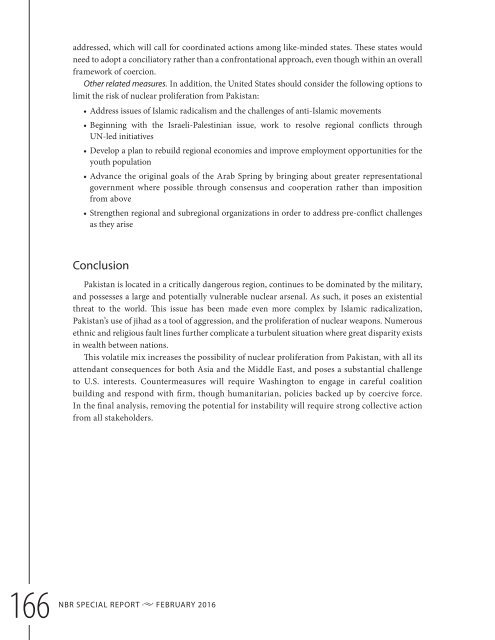pakistan’s
SR55_Mapping_Pakistan_February2016
SR55_Mapping_Pakistan_February2016
Create successful ePaper yourself
Turn your PDF publications into a flip-book with our unique Google optimized e-Paper software.
addressed, which will call for coordinated actions among like-minded states. These states would<br />
need to adopt a conciliatory rather than a confrontational approach, even though within an overall<br />
framework of coercion.<br />
Other related measures. In addition, the United States should consider the following options to<br />
limit the risk of nuclear proliferation from Pakistan:<br />
• Address issues of Islamic radicalism and the challenges of anti-Islamic movements<br />
• Beginning with the Israeli-Palestinian issue, work to resolve regional conflicts through<br />
UN-led initiatives<br />
• Develop a plan to rebuild regional economies and improve employment opportunities for the<br />
youth population<br />
• Advance the original goals of the Arab Spring by bringing about greater representational<br />
government where possible through consensus and cooperation rather than imposition<br />
from above<br />
• Strengthen regional and subregional organizations in order to address pre-conflict challenges<br />
as they arise<br />
Conclusion<br />
Pakistan is located in a critically dangerous region, continues to be dominated by the military,<br />
and possesses a large and potentially vulnerable nuclear arsenal. As such, it poses an existential<br />
threat to the world. This issue has been made even more complex by Islamic radicalization,<br />
Pakistan’s use of jihad as a tool of aggression, and the proliferation of nuclear weapons. Numerous<br />
ethnic and religious fault lines further complicate a turbulent situation where great disparity exists<br />
in wealth between nations.<br />
This volatile mix increases the possibility of nuclear proliferation from Pakistan, with all its<br />
attendant consequences for both Asia and the Middle East, and poses a substantial challenge<br />
to U.S. interests. Countermeasures will require Washington to engage in careful coalition<br />
building and respond with firm, though humanitarian, policies backed up by coercive force.<br />
In the final analysis, removing the potential for instability will require strong collective action<br />
from all stakeholders.<br />
166<br />
NBR<br />
SPECIAL REPORT u FEBRUARY 2016



